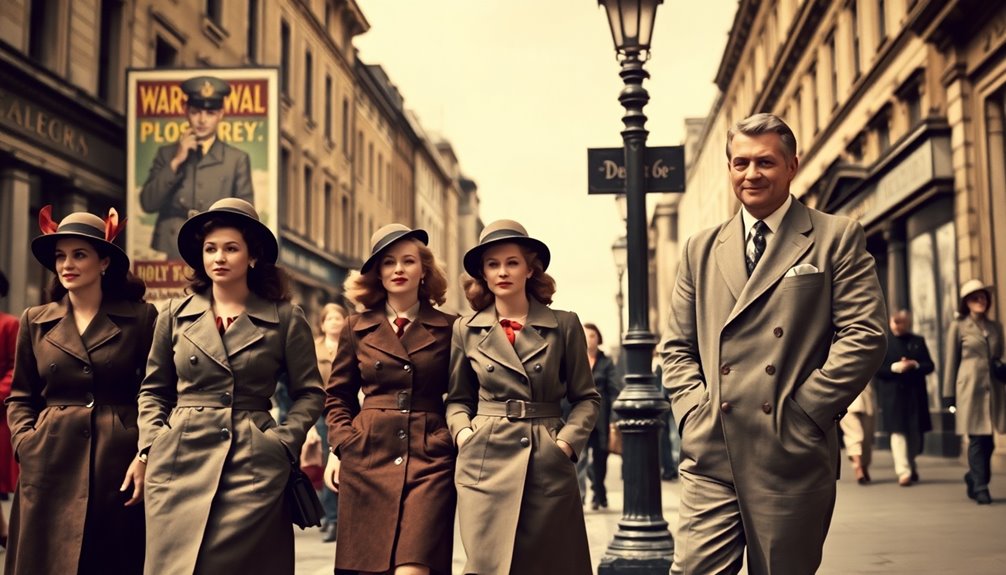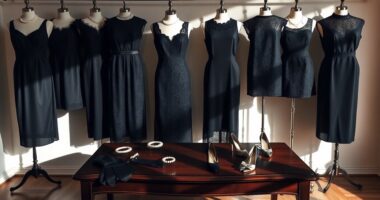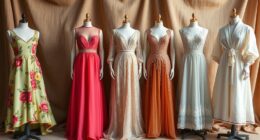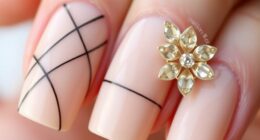War times have greatly impacted fashion trends, forcing designs to prioritize practicality and functionality. You’ll find that wartime fabric rationing led to simpler, utility styles, while military uniforms inspired everyday clothing, like trench coats and bomber jackets. Women’s fashion reflected their new roles, emphasizing tailored looks and empowerment. As society shifted post-war, fashion embraced luxury, yet echoes of wartime simplicity remain today. Discover how these historical shifts continue to shape our modern wardrobe choices.
Key Takeaways
- Wartime fabric rationing led to the creation of practical utility fashion, emphasizing functionality over ornamentation.
- Women’s clothing adopted military styles, with tailored suits and padded shoulders symbolizing empowerment during WWII.
- Economic constraints during conflicts shifted fashion towards modest, durable, and ready-to-wear clothing, reflecting societal needs.
- Post-war, the transition to luxury fashion marked a societal shift from wartime austerity to peacetime opulence, as seen in Dior’s New Look.
- The legacy of wartime fashion continues to influence modern styles, showcasing a blend of functionality and military aesthetics in everyday wear.
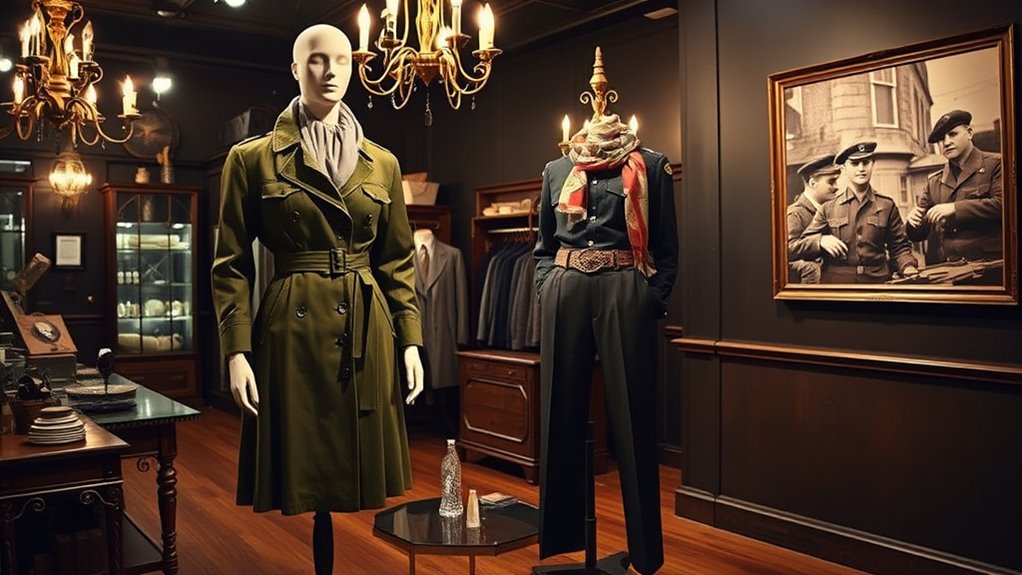
Throughout history, wars have shaped not just the battlefield but also the fashion landscape, influencing what we wear in profound ways. During World War II, for example, fabric rationing led to the rise of utility fashion, where clothing became more functional and stripped of excess ornamentation. You’ll notice that this shift didn’t just affect military personnel; it permeated civilian wardrobes too, reflecting the changing roles of women in the workforce. As women stepped into new jobs, their clothing evolved, embracing practicality over extravagance.
Military uniforms had a significant impact on civilian fashion, giving birth to styles like trench coats and bomber jackets that have since become staples in your closet. These items, originally designed for soldiers, now resonate with everyday wear, proving that functionality can be stylish. The use of durable materials like canvas in military gear inspired similar choices in civilian clothing, seen today in cargo pants and combat boots. Even leather jackets, once reserved for the armed forces, have found a permanent place in fashion.
Military uniforms have profoundly shaped civilian fashion, inspiring durable styles like trench coats, bomber jackets, and leather jackets that blend functionality with everyday wear.
The economic factors of the Great Depression and wartime austerity also shifted the focus toward practicality. Fashion became about timeless, modest styles that offered durability rather than luxury. As you browse through vintage shops or modern collections, you might notice how these historical challenges have influenced contemporary styles. The emphasis on ready-to-wear clothing gained traction during these periods, as economic constraints made elaborate designs less feasible.
Social and cultural shifts during wartime further shaped what you wear. The emergence of the ‘Rosie the Riveter’ look during WWII symbolized a new era of female empowerment, with women adopting tailored suits and knee-length skirts that allowed for movement and independence. The padded shoulders in women’s clothing echoed military aesthetics, reinforcing the connection between wartime roles and fashion trends.
In contrast, peacetime fashion often leans towards the ornate and extravagant. After WWII, when Dior introduced the New Look in 1947, society embraced luxury and opulence, signaling a departure from the utility styles born from wartime necessity. This change illustrates how fashion reflects broader societal shifts and attitudes.
Ultimately, the legacy of wartime fashion trends endures, with practicality and functionality still influencing modern styles. The echoes of military influence continue to shape what you wear, reminding us that fashion isn’t just about aesthetics; it’s a narrative of history, culture, and resilience.
Frequently Asked Questions
How Did Wartime Rationing Affect Fabric Availability in Fashion?
Wartime rationing dramatically affected fabric availability in fashion. You’d find key materials like silk and wool scarce, as they were redirected for military use.
This shortage forced you to get creative with fabric choices, often opting for alternatives like rayon and nylon. The coupon system limited your clothing purchases, encouraging resourcefulness.
You’d likely repair or repurpose garments, making it a patriotic act while embracing simpler, more practical designs in your wardrobe.
What Role Did Female Empowerment Play in Fashion During War?
Female empowerment during wartime revolutionized fashion like a lightning bolt striking a tree, transforming everything in its path.
You saw women step into roles that demanded practicality, leading to bolder styles like pants and overalls. These choices reflected newfound autonomy and a break from traditional norms.
As women embraced their strength, fashion became a canvas for self-expression, redefining identity and showcasing resilience amid social change, ultimately reshaping the entire industry for years to come.
Did Military Uniforms Inspire Civilian Fashion Trends After the War?
Yes, military uniforms greatly inspired civilian fashion trends after the war.
You’ll notice how elements like structured tailoring, khaki colors, and combat boots shifted into everyday wear. Styles such as bomber jackets and camouflage prints became staples in streetwear.
These military influences not only offer practicality and durability but also evoke a sense of adventure and authority.
You can see this trend reflected in both high fashion and casual attire today.
How Have Modern Conflicts Influenced Contemporary Fashion Designers?
Modern conflicts shape your fashion landscape by pushing designers to innovate. You see them experimenting with alternative materials due to resource scarcity, creating functional yet stylish pieces.
They often make political statements through their collections, reflecting societal issues. Additionally, you’ll notice global collaborations resulting in diverse influences.
As a consumer, you benefit from this blend of practicality and creativity, making fashion not just a statement but a response to contemporary challenges.
What Historical Events Most Significantly Impacted Fashion Trends During Wartime?
You’d think wars were just about battles and bravery, but oh no, they’ve got a flair for fashion too!
Historical events like World War I and II shoved practicality into the spotlight, forcing everyone to swap silk for sturdy fabrics.
Women donned pants—gasp!—and men embraced trench coats, all while thrifting became the new chic.
Conclusion
So, next time you slip into those trendy combat boots or sport a military-style jacket, remember: you’re not just making a fashion statement; you’re paying homage to the battlefield. Who knew that war could inspire such chic looks? Forget about haute couture; it’s all about “haute combat” now! In a world where practicality meets style, you might just find yourself in the trenches of fashion history. Now, go forth and strut your stuff like a fashion soldier!

